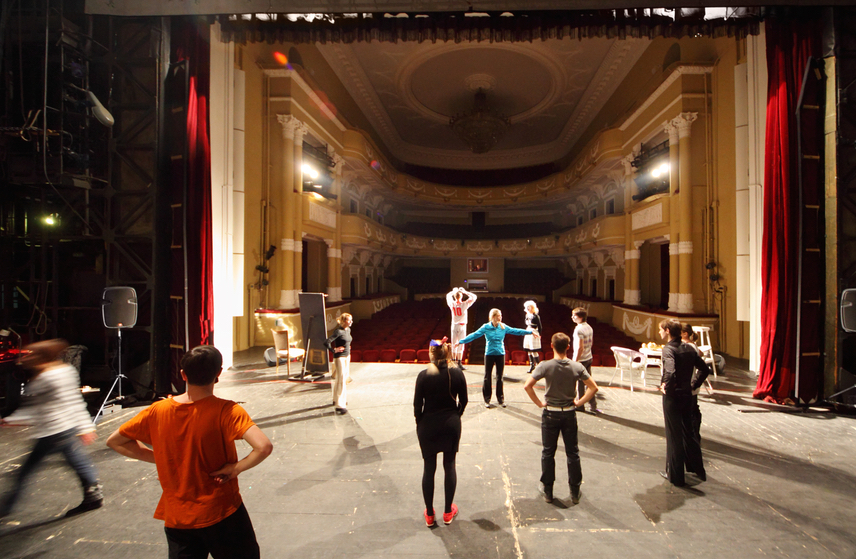
Early in my career I was a theater director. My approach was to be as collaborative as possible while still conveying my vision about the play. I had a picture in my mind’s eye of how it would all go, like a film running inside my head. My job, as director, was to share this with the actors, designers, and the production team, to describe it to them, and direct them how to do the play.
What I quickly learned was that much gets lost in translation. Telling actors where to stand, how to stand, and who to face may create a pretty picture on stage, but rarely conveys the emotional and intellectual intention of a nuanced and well-crafted story. Often, a group of actors on break, standing around talking, is more interesting. Then there are those moments in the middle of rehearsal or performance when the boundaries and structures, so carefully constructed, slip away and through the people on stage (and off) authenticity emerges. Everyone feels it, gives into it, and lets it take us into a whole new territory to be explored and shared. This is how an ensemble brings vision into being.
In its greatest potency vision is defined as a verb — to imagine. For it to thrive within a team, it must be more than one individual’s imagination. A singular idea can serve as the spark but it takes diverse perspectives and capabilities to fan the flames and build the fire. In the context of a team within an organization or an ensemble of actors on stage, a more accurate definition for vision is to imagine…together.
The notion of this is exciting, yet shared visions are often seen through the lens of “me” not “we.” Teams work within structural and political frames, there is always a boss or someone with the power to shape the outcome. Along the way there are hurt feelings, team members who leave or are asked to leave, and great ideas overlooked, appropriated, or purposefully left unacknowledged. The day-to-day demands of work can be overpowering.
Thus it takes courage to imagine…together.
All ensembles are developed out of a group of individuals each making their own choices. Though the commitments made are rarely clear, even to the person making it, it becomes every ensemble member’s job to inspire engagement with one another and cultivate it. This brings us to a deeper understanding of leadership — one that transcends positional power. Robert Greenleaf called it “servant leadership” and MIT Professor Otto Scharmer defines it as someone who “enhances the individual and systemic capacity to see, to deeply attend to the reality that people face and enact. Thus the leader’s real work is to help people discover the power of seeing and seeing together.”
Through my early work as a stage director and later as a capacity builder working with leaders, teams, and coalitions, three key capabilities for visioning through an ensemble have become clear: listening, rehearsing, and building trust.
When you are training to be an actor, you stand face to face with another person and learn how to listen. Not just hearing what she or he is saying, but seeing and feeling for her or his deepest intention by observing every subtlety. In the work setting this might be alarming and potentially overwhelming. Yet, deep listening requires us to fully show up and to withhold judgement of the other person. For a split second we are putting aside our own needs, desires, and motivations in order to better understand the circumstances we occupy with the other person (or people) in the room. Vision requires this for the basic reason that it is impossible to “see” together if we are all caught up in our own point of view.
Rehearsing builds vision by giving us the chance to synthesize and test ideas, surrender our assumptions, and welcome new approaches. Pangea World Theatre begins every rehearsal and meeting with a bell chime and two minutes of quiet contemplation. This centering ritual marks the beginning of the ensemble’s creative exploration. Simply, it refocuses everyone’s energy from what was going on outside to what is about to happen inside the room. In the work setting, there are multiple opportunities for rehearsing— strategic planning collaborations go in search of vision, staff and board meetings are platforms for coordinating and improving it, and day-to-day team member interactions, over seemingly insignificant details, give it shape and meaning. We need to use these spaces with intention and purpose.
At the Commonweal Theater Company, before the actors go on stage, they stand in a circle and look each other in the eye, and say “I will hold you up.” This serves as affirmation of the choice each member of the ensemble makes to ensure no one is out there on stage alone. That despite the motivations of their individual parts or however the direction the performance that night will take, they will not let each other down. Cultivating this kind of trust is both difficult and necessary. We do this by hanging in there with each other especially at the most difficult moments. This is where we, through our words and actions, each individually make a choice— do we exit stage left or hold each other up?
For me, I work at building these capabilities every day. It is humbling when my collaborators and I are able to work this way together. At the same time, it is gratifying to see something new or absent emerge through the unique voices, strengths, and assets of our ensemble. Baked into this are beautiful surprises that help us see the world in a different way. For me, it recuts the small, little movie in my head and breathes life into an honest and compelling work of art that can live in the world.

